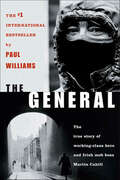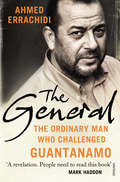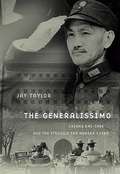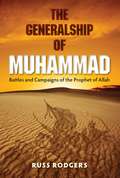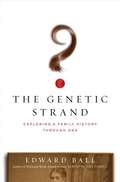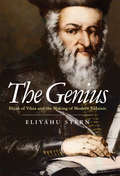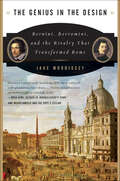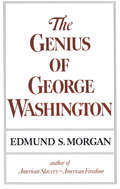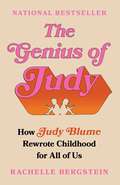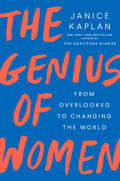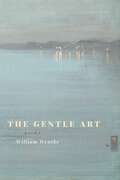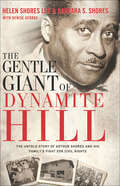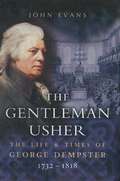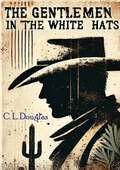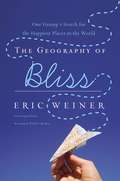- Table View
- List View
The General: The True Story of Working-Class Hero and Irish Mob Boss Martin Cahill
by Paul WilliamsIn a twenty-year career marked by obsessive secrecy, brutality, and meticulous planning, Martin Cahill, a k a, The General, netted over 40 million pounds. His criminal record included assassination, kidnapping, bombings, and one of the world's largest art and gold heists! He was untouchable and fiercely loyal to his gang. Loved by the common man, his personal battle with the police made him a living legend. But Martin Cahill not only refused to respect the police, he refused to pay tribute to the IRA. And unlike the police who had to follow the letter of the law in their battle to bring down Ireland's most wanted, the IRA played by their own rules.At the Publisher's request, this title is being sold without Digital Rights Management Software (DRM) applied.
The General: The ordinary man who challenged Guantanamo
by Gillian Slovo Ahmed ErrachidiOn 11 September 2001, in a café in London, Ahmed Errachidi watched as the twin towers collapsed. He was appalled by the loss of innocent life. But he couldn’t possibly have predicted how much of his own life he too would lose because of that day.In a series of terrible events, Ahmed was sold by the Pakistanis to the Americans in the diplomatic lounge at Islamabad airport and spent five and a half years in Guantanamo. There, he was beaten, tortured, humiliated, very nearly destroyed.But Ahmed did not give in. This very ordinary, Moroccan-born London chef became a leader of men. Known by the authorities as The General, he devised protests and resistance by any means possible. As a result, he spent most of his time in solitary confinement. But then, after all those years, Ahmed was freed, his innocence admitted.This is Ahmed’s story. It will make you rethink what it means to be in the wrong place at the wrong time. It will also make you look anew at courage, survival, justice and the War on Terror.
The Generalissimo: Chiang Kai-Shek and the Struggle for Modern China
by Jay TaylorThe Generalissimo provides the most lively, sweeping, and objective biography of Chiang Kai-shek and the struggle for modern China.
The Generalship of Muhammad: Battles and Campaigns of the Prophet of Allah
by Russ RodgersThere are many biographies of the Prophet, and they tend to fall into three categories: pious works that emphasize the virtues of the early Islamic community, general works for non-Muslim or non-specialist readers, and source-critical works that grapple with historiographical problems inherent in early Islamic history. In The Generalship of Muhammad, Russ Rodgers charts a new path by merging original sources with the latest in military theory to examine Muhammad's military strengths and weaknesses.Incorporating military, political, and economic analyses, Rodgers focuses on Muhammad’s use of insurgency warfare in seventh-century Arabia to gain control of key cities such as Medina. Seeking to understand the operational aspects of these world-changing battles, he provides battlefield maps and explores the supply and logistic problems that would have plagued any military leader at the time.Rodgers explains how Muhammad organized his forces and gradually built his movement against sporadic resistance from his foes. He draws from the hadith literature to shed new light on the nature of the campaigns. He examines the Prophet's intelligence network and the employment of what would today be called special operations forces. And he considers the possibility that Muhammad received outside support to build and maintain his movement as a means to interdict trade routes between the Byzantine Empire and the Sasanid Persians.
The Genetic Strand
by Edward BallThe Genetic Strand is the story of a writer's investigation, using DNA science, into the tale of his family's origins. National Book Award winner Edward Ball has turned his probing gaze on the microcosm of the human genome, and not just any human genome -- that of his slave-holding ancestors. What is the legacy of such a family history, and can DNA say something about it? In 2000, after a decade in New York City, Ball bought a house in Charleston, South Carolina, home to his father's family for generations, and furnished it with heirloom pieces from his relatives. In one old desk he was startled to discover a secret drawer, sealed perhaps since the Civil War, in which someone had hidden a trove of family hair, with each lock of hair labeled and dated. The strange find propelled him to investigate: what might DNA science reveal about the people -- Ball's family members, long dead -- to whom the hair had belonged? Did the hair come from white relatives, as family tradition insisted? How can genetic tests explain personal identity? Part crime-scene investigation, part genealogical romp, The Genetic Strand is a personal odyssey into DNA and family history. The story takes the reader into forensics labs where technicians screen remains, using genetics breakthroughs like DNA fingerprinting, and into rooms where fathers nervously await paternity test results. It also summons the writer¹s entertaining and idiosyncratic family, such as Ball¹s antebellum predecessor, Aunt Betsy, who published nutty books on good Southern society; Kate Fuller, the enigmatic ancestor who may have introduced African genes into the Ball family pool; and the author¹s first cousin Catherine, very much alive, who donates a cheek swab from a mouth more attuned to sweet iced tea than DNA sampling. Writing gracefully but pacing his story like an old-fashioned whodunit, Edward Ball tracks genes shared across generations, adding suspense and personal meaning to what the scientists and Nobel laureates tell us. A beguiling DNA tale, The Genetic Strand reaches toward a new form of writing<the genetic memoir.
The Genius
by Eliyahu SternElijah ben Solomon, the "Genius of Vilna,” was perhaps the best-known and most understudied figure in modern Jewish history. This book offers a new narrative of Jewish modernity based on Elijah's life and influence. While the experience of Jews in modernity has often been described as a process of Western European secularization—with Jews becoming citizens of Western nation-states, congregants of reformed synagogues, and assimilated members of society—Stern uses Elijah’s story to highlight a different theory of modernization for European life. Religious movements such as Hasidism and anti-secular institutions such as the yeshiva emerged from the same democratization of knowledge and privatization of religion that gave rise to secular and universal movements and institutions. Claimed by traditionalists, enlighteners, Zionists, and the Orthodox, Elijah’s genius and its afterlife capture an all-embracing interpretation of the modern Jewish experience. Through the story of the “Vilna Gaon,” Stern presents a new model for understanding modern Jewish history and more generally the place of traditionalism and religious radicalism in modern Western life and thought.
The Genius in the Design: Bernini, Borromini, and the Rivalry That Transformed Rome
by Jake Morrissey“The remarkable story of the two seventeenth-century geniuses. . . . A highly successful double biography.” —BooklistThe rivalry between the brilliant seventeenth-century Italian architects Gianlorenzo Bernini and Francesco Borromini is the stuff of legend. Enormously talented and ambitious artists, they met as contemporaries in the building yards of St. Peter’s in Rome, became the greatest architects of their era by designing some of the most beautiful buildings in the world, and ended their lives as bitter enemies. Engrossing and impeccably researched, full of dramatic tension and breathtaking insight, The Genius in the Design is the remarkable tale of how two extraordinary visionaries schemed and maneuvered to get the better of each other and, in the process, created the spectacular Roman cityscape of today.“Entertaining. . . . Morrissey finely renders the intense rivalry between these two artists.” —Publishers Weekly“With clear prose and splendid touches of drama, history and architecture are both brought wonderfully to life.” —Ross King, New York Times bestselling author of Brunelleschi’s Dome and Michelangelo and the Pope’s Ceiling“Engrossing.” —Matthew Pearl, of The Dante Club“Genius in the Design reveals the dark side of 17th Century Italy with sparkling anecdotes and you-are-there immediacy” —Laurence Bergreen, author of Over the Edge of the World“Fascinating . . . a scintillating introduction to the Baroque.” —Iain Pears, New York Times bestselling author An Instance of the Fingerpost “Page-turning reading.” —Seattle Times Book Review“Morrissey illuminates the contrast between the celebrated Bernini and the anguished Borromini.” —Boston Globe
The Genius of Birds
by Jennifer Ackerman<P>Birds are astonishingly intelligent creatures. In fact, according to revolutionary new research, some birds rival primates and even humans in their remarkable forms of intelligence. Like humans, many birds have enormous brains relative to their size. Although small, bird brains are packed with neurons that allow them to punch well above their weight. <P> In The Genius of Birds, acclaimed author Jennifer Ackerman explores the newly discovered brilliance of birds and how it came about. As she travels around the world to the most cutting-edge frontiers of research-- the distant laboratories of Barbados and New Caledonia, the great tit communities of the United Kingdom and the bowerbird habitats of Australia, the ravaged mid-Atlantic coast after Hurricane Sandy and the warming mountains of central Virginia and the western states--Ackerman not only tells the story of the recently uncovered genius of birds but also delves deeply into the latest findings about the bird brain itself that are revolutionizing our view of what it means to be intelligent. <P>Consider, as Ackerman does, the Clark's nutcracker, a bird that can hide as many as 30,000 seeds over dozens of square miles and remember where it put them several months later; the mockingbirds and thrashers, species that can store 200 to 2,000 different songs in a brain a thousand times smaller than ours; the well-known pigeon, which knows where it's going, even thousands of miles from familiar territory; and the New Caledonian crow, an impressive bird that makes its own tools. <P>But beyond highlighting how birds use their unique genius in technical ways, Ackerman points out the impressive social smarts of birds. They deceive and manipulate. They eavesdrop. They display a strong sense of fairness. They give gifts. They play keep-away and tug-of-war. They tease. They share. They cultivate social networks. They vie for status. They kiss to console one another. They teach their young. They blackmail their parents. They alert one another to danger. They summon witnesses to the death of a peer. They may even grieve. <P>This elegant scientific investigation and travelogue weaves personal anecdotes with fascinating science. Ackerman delivers an extraordinary story that will both give readers a new appreciation for the exceptional talents of birds and let them discover what birds can reveal about our changing world. Incredibly informative and beautifully written, The Genius of Birds richly celebrates the triumphs of these surprising and fiercely intelligent creatures. <P><b>A New York Times Bestseller</b>
The Genius of George Washington
by Edmund S. MorganMore than any other single man, George Washington was responsible for bringing success to the American Revolution. But because of the heroic image in which we have cast him and which already enveloped him in this own lifetime, Washington is and was a hard man to know. In this book Edmund S. Morgan pushes past the image to find the man. He argues that Washington's genius lay in his understanding of both military and political power. This understanding of power was unmatched by that of any of his contemporaries and showed itself at the simplest level in the ability to take command. Drawing on Washington's letters to his colleagues (many of which are included in this book), Morgan explores the particular genius of our first president and clearly demonstrates that Washington's mastery of power allowed America to win the Revolutionary War and placed the new country on the way to achieving the international and domestic power that Washington himself had sought for it.
The Genius of Jane Austen: Her Love of Theatre and Why She Works in Hollywood
by Paula ByrnePerfect for fans of Jane Austen, this updated edition of Paula Byrne's debut book includes new material that explores the history of Austen stage adaptations, why her books work so well on screen, and what that reveals about one of the world's most beloved authors.Originally published by Bloomsbury Academic in 2003 as Jane Austen and the Theatre, Paula Byrne's first book was never made widely available in the US and is out of print today. An exploration of Austen's passion for the stage—she acted in amateur productions, frequently attended the theatre, and even scripted several early works in play form—it took a nuanced look at how powerfully her stories were influenced by theatrical comedy.This updated edition features an introduction and a brand new chapter that delves into the long and lucrative history of Austen adaptations. The film world's love affair with Austen spans decades, from A.A. Milne's "Elizabeth Bennet," performed over the radio in 1944 to raise morale, to this year's Love and Friendship. Austen's work has proven so abidingly popular that these movies are more easily identifiable by lead actor than by title: the Emma Thompson Sense and Sensibility, the Carey Mulligan Northanger Abbey, the Laurence Olivier Pride and Prejudice. Byrne even takes a captivating detour into a multitude of successful spin-offs, including the phenomenally brilliant Clueless. And along the way, she overturns the notion of Jane Austen as a genteel, prim country mouse, demonstrating that Jane's enduring popularity in film, TV, and theater points to a woman of wild comedy and outrageous behavior.For lovers of everything Jane Austen, as well as for a new generation discovering her for the first time, The Genius of Jane Austen demonstrates why this beloved author still resonates with readers and movie audiences today.
The Genius of Judy: How Judy Blume Rewrote Childhood for All of Us
by Rachelle BergsteinNATIONAL BESTSELLER An intimate and expansive look at Judy Blume&’s life, work, and cultural impact, focusing on her most iconic—and controversial—young adult novels, from Are You There God? It&’s Me, Margaret. to Blubber.Everyone knows Judy Blume. Her books have garnered her fans of all ages for decades and sold tens of millions of copies. But why were people so drawn to them? And why are we still talking about them now in the 21st century? In The Genius of Judy, her remarkable story is revealed as never before, beginning with her as a mother of two searching for purpose outside of her home in 1960s suburban New Jersey. The books she wrote starred regular children with genuine thoughts and problems. But behind those deceptively simple tales, Blume explored the pillars of the growing women&’s rights movement, in which girls and women were entitled to careers, bodily autonomy, fulfilling relationships, and even sexual pleasure. Blume wasn&’t trying to be a revolutionary—she just wanted to tell honest stories—but in doing so, she created a cohesive, culture-altering vision of modern adolescence. Blume&’s bravery provoked backlash, making her the country&’s most-banned author in the mid-1980s. Thankfully, her works withstood those culture wars and it&’s no coincidence that Blume has resurfaced as a cultural touchstone now. Young girls are still cat-called, sex education curricula are getting dismissed as pornography, and entire shelves of libraries are being banned. As we face these challenges, it&’s only natural we look to Blume, the grand dame of so-called dirty books. This is the story of how a housewife became a groundbreaking artist, and how generations of empowered fans are her legacy, today more than ever.
The Genius of Women: From Overlooked to Changing the World
by Janice KaplanWe tell girls that they can be anything, so why do 90 percent of Americans believe that geniuses are almost always men? New York Times bestselling journalist Janice Kaplan explores the powerful forces that have rigged the system—and celebrates the women geniuses past and present who have triumphed anyway. Even in this time of rethinking women&’s roles, we define genius almost exclusively through male achievement. When asked to name a genius, people mention Albert Einstein, Leonardo da Vinci, and Steve Jobs. As for great women? In one survey, the only female genius anyone listed was Marie Curie. Janice Kaplan, the New York Times bestselling author of The Gratitude Diaries, set out to determine why the extraordinary work of so many women has been brushed aside. Using her unique mix of memoir, narrative, and inspiration, she makes surprising discoveries about women geniuses now and throughout history, in fields from music to robotics. Through interviews with neuroscientists, psychologists, and dozens of women geniuses at work in the world today—including Nobel Prize winner Frances Arnold and AI expert Fei-Fei Li—she proves that genius isn't just about talent. It's about having that talent recognized, nurtured, and celebrated. Across the generations, even when they face less-than-perfect circumstances, women geniuses have created brilliant and original work. In The Genius of Women, you&’ll learn how they ignored obstacles and broke down seemingly unshakable barriers. The geniuses in this moving, powerful, and very entertaining book provide more than inspiration—they offer a clear blueprint to everyone who wants to find her own path and move forward with passion.
The Genius: How Bill Walsh Reinvented Football and Created an NFL Dynasty
by David HarrisThe Genius is the gripping account of Bill Walsh's career and how, through tactical and organizational skill, he transformed the San Francisco Forty Niners from a fallen franchise into a football dynasty. Along with his right-hand man John McVay, Walsh built the foundation for this success by drafting or trading for a durable core of stars, including Joe Montana, Fred Dean, and Hacksaw Reynolds. (Walsh would later restock the team with such players as Jerry Rice, Steve Young, and Charles Haley.) The key to Walsh's genius perhaps lay in his keen understanding of his athletes' psyches-- he knew what brought out the best in each of them. With unmatched access to players, fellow coaches, executives, beat reporters, and Walsh himself, David Harris recounts the whole story--including Walsh's pre-Niners odyssey, the demons that pushed him throughout his career, and the scope of his impact on the game beyond the field and locker room. In the end, Harris reveals the brilliant man behind the coaching legend.
The Genius: How Bill Walsh Reinvented Football and Created an NFL Dynasty
by David HarrisThe Genius is the gripping and definitive account of Bill Walsh's career and how he built a football dynasty from the rubble of a fallen franchise. David Harris gives a stellar account of the silver-haired sophisticate from humble working-class roots who was hired as head coach and general manager of the San Francisco Forty Niners in January 1979 and became the architect of what is arguably the greatest ten-year run in NFL history. With unmatched access to players, fellow coaches, executives, the reporters who covered the Niners' heyday, and Walsh himself, Harris recounts how Walsh, through tactical and organizational genius, created a football juggernaut. There were also the demons that pushed and haunted Walsh throughout his career: his clash with his former mentor, Paul Brown, who denied Walsh his first pro head-coaching job with the Cincinnati Bengals; Walsh's struggle with self-doubt and criticism; the toll his single-minded devotion to football exacted on his family; and his complex relationship with the Forty Niners' owner, Edward DeBartolo, Jr.Walsh's pre-Niners coaching odyssey was arduous-a longtime assistant coach, he developed his legendary and now-standard pass-oriented West Coast offense during stops at all levels of the game. Despite never having run a team's draft before, Walsh, along with his right-hand man John McVay, quickly built the foundation for a dynasty by drafting or trading for a durable core of stars, including Joe Montana, Fred Dean, Hacksaw Reynolds, Dwight Clark, and Ronnie Lott. (Walsh would later restock the team with such players as Jerry Rice, Steve Young, and Charles Haley.) The key to Walsh's genius perhaps lay in his keen understanding of his athletes' psyches-he knew what brought out the best in each of them. But the scope of Walsh's impact on the game extended well beyond the field and locker room. The Forty Niners' life-skills counseling program, which Walsh spearheaded with the sports sociologist and activist Dr. Harry Edwards, and the internship program Walsh devised to bring minority coaches into the game have since been adopted by the NFL for all league franchises.In the annals of sport, few individuals have had as great an impact on their game-or on its relevance to life outside the lines-as Bill Walsh. With knowledge, skill, passion, and a critical eye, David Harris reveals the brilliant man behind the coaching legend.The vision Bill Walsh brought to all his pioneering efforts was a function of his perception of himself as someone who was far more than a football coach. He cherished his standing and participation in the larger world outside the NFL and nurtured them at every opportunity."Knowing Bill Walsh was kind of like the blind man describing an elephant," one of the sportswriters who covered him observed. "We all knew just one little piece of him. But he had all these other areas we knew nothing about. He dealt with lots of people outside of football, outside of our scope entirely. He was able to deal with politicians, people who were intellects in other areas. They were impressed by him."-from The GeniusFrom the Hardcover edition.
The Genre of Acts and Collected Biography
by Sean A. AdamsIt is widely accepted by New Testament scholars that the Gospel of Luke and the Acts of the Apostles probably originated as two parts of one work by a single author. In spite of this, the books have been assigned to very different genres: Luke is traditionally viewed as a biography of Jesus, and Acts as a history of the early church. Comparing in detail the structure and content of Acts with the formal features of history, novel, epic and biography, Sean Adams challenges this division. Applying both ancient and modern genre theory, he argues that the best genre parallel for the Acts of the Apostles is in fact collected biography. Offering a nuanced and sophisticated understanding of genre theory, along with an insightful argument regarding the composition and purpose of Acts, this book will be of interest to those studying the New Testament, Acts, genre theory and ancient literature.
The Gentle Art of Matchmaking and Other Important Things
by John B. Keane[from the back cover] "John B. Keane was born in Listowel in 1928. Having worked in a variety of jobs in Ireland and England, he married and settled down to run a pub in his native town. Now he is recognised as a major Irish writer, who has written many successful plays and books, Sive, Sharon's Grave, The Highest House on the Mountain, The man from Clare, The Year of the Hiker, The Field, Many Young Men of Twenty, Big Maggie, Moll, Self-Portrait, Letters of a Successful T.D. and Letters of an Irish Parish Priest. This book offers a feast of Keane. The title essay reminds us that, while some marriages are proverbially made in Heaven, others have been made in the back parlour of a celebrated pub in Listowel--and none the worse for that! But John B. Keane has other interests besides match-making, and these pieces mirror many moods and attitudes. Who could ignore Keane on Potato-Cakes? Keane on Skinless Sausages, On Half-Doors? Is there a husband alive who will not recognise someone near and dear to him when he reads, with a mixture of affection and horror, the essay on 'Female Painters'? And, more seriously, there are other pieces that reflect this writer's deep love of tradition; his nostalgic re-creation of an Irish way of life that is gone for ever. Admirers of his plays will recognise in 'Sideways Talkers' and 'the Spirit of Christmas' the ruthless economy of a dramatist who can conjure up a character and a situation in a few lines. The Style is the Man' is a true saying and it has never been more true of any writer than of John B. Keane. He is there-with every inimitable quirk and foible in every line he writes. The characters in his plays are varied enough, but they all bear the stamp of the man who created them. In these essays, where he talks to us directly, his personality sounds out behind every line. No one who has read Letters of a Successful T.D. or seen his plays or encountered 'John B.' on radio or television will dare to miss the Gentle Art of Matchmaking."
The Gentle Art: Poems
by William WentheThe poems in The Gentle Art, a compelling new collection from William Wenthe, move between the life of the painter James McNeill Whistler and a poetic version of the author, who is at once inspired and disturbed by Whistler. The present-day author sheds light on Whistler’s artistic vocation and the beauty of his paintings, most notably the liminal London riverscapes that he named Nocturnes, yet recoils at the cost of Whistler’s devotion to art: lovers abandoned, friends turned into enemies, his own children given away to adoption.Creating a kind of dual biography, Wenthe grapples with feelings of admiration and disaffection toward Whistler as he tries to perform his own roles as parent, partner, and poet. While some of the poems are narrative, their overall effect is associative—two lives superimposed in a double exposure, with attention to what the contrast of two centuries, the nineteenth and the twenty-first, reveals about the relationship of art to money, class, and politics.
The Gentle Barbarian
by Bohumil HrabalAn unforgettable portrait of a major pioneering artist, by “Czechoslovakia’s greatest writer” (Milan Kundera) The Gentle Barbarian is Bohumil Hrabal’s homage to Vladimír Boudník, one of the greatest Czech visual artists of the 1950s and 1960s, whose life came to a tragic end shortly after the Soviet invasion of 1968. Boudnik and Hrabal had a close and often contentious friendship. For a brief period, in the early 1950s, they both worked in the steel works in Kladno and lived in the same building in Prague. Written in the early seventies, Hrabal’s anecdotal portrait of Boudnik includes another controversial member of that early group of the Czech avant-garde: the poet Egon Bondy. While Hrabal and Bondy were evolving their aesthetic of “total realism,” Boudnik developed his own artistic approach that he called “Explosionalism,” in which the boundaries between life and art become blurred, and everyday events take on the appearance and the substance of art. Hrabal’s portrait of Boudnik captures the strange atmosphere of a time in which the traditional values and structures of everyday life in Czechoslovakia were being radically dismantled by the Communists. But as The Gentle Barbarian demonstrates, creative spirits are able to reject, ignore, or burrow beneath the superficial “revolutionary” atmosphere of the time, and find humor, inspiration, and a kind of salvation amidst its general intellectual and creative poverty.
The Gentle Giant of Dynamite Hill: The Untold Story of Arthur Shores and His Family's Fight for Civil Rights
by Denise George Helen Shores Lee Barbara S. ShoresThese are the firsthand accounts of sisters Helen and Barbara Shores growing up with their father, Arthur Shores, a prominent Civil Rights attorney, during the 60s in the Jim Crow south Birmingham district—a frequent target of the Ku Klux Klan. Between 1948 and 1963, some 50 unsolved Klan bombings happened in Smithfield where the Shores family lived, earning their neighborhood the nickname “Dynamite Hill.”Due to his work, Shores’ daughter, Barbara, barely survived a kidnapping attempt. Twice, in 1963, Klan members bombed their home, sending Theodora to the hospital with a brain concussion and killing Tasso, the family’s cocker spaniel. The family narrowly escaped a third bombing attempt on their home in the spring of 1965. The Gentle Giant of Dynamite Hill is an incredible story of a family’s unfair suffering, but also of the Shores’ overcoming. This family’s sacrificial commitment, courage, determination, and triumph inspire us today through this story and the selfless service, work, and lives of Helen Shores Lee and Barbara Sylvia Shores.
The Gentle Puritan: A Life of Ezra Stiles, 1727-1795 (Published by the Omohundro Institute of Early American History and Culture and the University of North Carolina Press)
by Edmund S. MorganNow available again, this important biography of the early New England intellectual leader was greeted as a "landmark in the history of the American mind" by Clifford K. Shipton when it appeared in 1962. Stiles lived at a critical time--the transition from the Reformation to the Enlightenment, which came suddenly in New England--and because of his position, his influence was great."Originally published in 1974.A UNC Press Enduring Edition -- UNC Press Enduring Editions use the latest in digital technology to make available again books from our distinguished backlist that were previously out of print. These editions are published unaltered from the original, and are presented in affordable paperback formats, bringing readers both historical and cultural value.
The Gentleman Banker: Amadeo Peter Giannini: A Biographical Novel
by Giorgio A. ChiarvaThis biographical novel recounts the extraordinary intuitions of the Italian-American visionary founder of the world’s largest bank, the Bank of America. Amadeo Peter, or AP for his San Francisco friends, dedicated his life to generate wealth for the people of his home town, in particular for the Italian immigrant’s community. He was an innovator and humanist, who always put the common good ahead of personal gain. He revolutionized the banking system when he financed the reconstruction of San Francisco after the 1906 earthquake by making micro-loans to hundreds of Italian immigrants lacking collateral. The other banks, which required collateral in order to make a loan, were unable to put the money into circulation. He was a visionary in the film industry, financing the movie, The Kid, by an unknown and extravagant Charlie Chaplin who was turned down by other banks. It was the first time a loan was granted without interest, and repaid from box office revenues. The same happened with Walt Disney for his masterpiece, Snow White. In addition, Giannini realized the potential of the new audio technology developed by two young inventors, Bill Hewlett and David Packard, and put them in touch with Disney for his following productions, and financed the industry that the two entrepreneurs began in a garage in Palo Alto. Another successful project financed by Giannini’s bank was the construction of the Golden Gate Bridge, designed by Joseph Strauss, an engineer without solid credentials, as a daring steel structure. The loan was granted without interest, with the understanding that it would be repaid from toll revenues. And it did, many times over. Giannini revealed his acumen as a venture capitalist when he persuaded Henry Kaiser to convert his enterprise from the construction of roads and bridges to ship building. During WWII, with Giannini’s encouragement, the shipyard was able to build 24 ships in record time, which were used to transport the troops to Europe. After the war, Giannini’s bank contributed $37M to Italy’s reconstruction, one year in advance of the Marshall Plan. And much more…This book tells it all.
The Gentleman Usher: The Life & Times of George Dempster 1712-1818
by John EvansGeorge Dempster was a giant of a man who became one of the best-known and most deservedly popular Scotsman of his day.He served for thirty years as an MP in Westminster and was closely involved with the expansion of British influence and trade across the world particularly in India and North America. This was the age of Empire building and great rivalry between competing powers, particularly France, which led to protracted warfare.A trained lawyer, Dempster was at the heart of political and business life and his circle of friends was large and powerful. Yet power did not corrupt him and he was respected by allies and opponents, being known as 'Honest George'. Master of the famous Skibo Estate in Sutherland, Dempster's energy was legendary and he used his talents as an entrepreneur and developer, bringing prosperity and jobs to disadvantaged regions.Dempster was more than an observer of history; he made it.
The Gentlemen in the White Hats: Dramatic Episodes in the History of the Texas Rangers
by C. L. DouglasThe Gentlemen in the White Hats by C. L. Douglas is a thrilling and richly detailed exploration of the legendary Texas Rangers, one of the most iconic law enforcement organizations in American history. Through vivid storytelling and meticulous research, Douglas brings to life the dramatic episodes, fearless characters, and enduring legacy of the Rangers, whose exploits have become the stuff of myth and folklore.From their formation in the early 19th century to their role in taming the lawless frontier, the Texas Rangers are portrayed as both protectors and warriors, navigating the complex and often violent challenges of the American Southwest. Douglas recounts their daring confrontations with outlaws, cattle rustlers, and renegades, as well as their involvement in pivotal historical moments, such as the battles along the U.S.-Mexico border and the fight against notorious criminals.The book highlights the colorful personalities of individual Rangers, whose bravery and resourcefulness epitomized the rugged spirit of the frontier. At the same time, Douglas offers a balanced perspective, addressing the controversies and challenges the Rangers faced, including their methods and the evolving nature of their role in a rapidly changing society.Rich with action, historical context, and larger-than-life characters, The Gentlemen in the White Hats captures the essence of the Texas Rangers as symbols of justice, resilience, and the enduring spirit of the American West. Douglas’s engaging prose and attention to detail make this a must-read for history enthusiasts, fans of Western lore, and anyone fascinated by the intersection of fact and legend in the shaping of American history.Perfect for readers who appreciate gripping tales of adventure and historical significance, this book offers an unforgettable journey into the dramatic and often dangerous world of the Texas Rangers.
The Gentlemen of 16 July
by Ken Follett Rene Louis Maurice"NO GUNS NO HATRED NO VIOLENCE." Ken Follett and Rene Louis Maurice's exciting account of the European crime of the century.
The Geography of Bliss: One Grump's Search for the Happiest Places in the World
by Eric WeinerWeiner investigates why some places are happy, notably the Netherlands, Switzerland, Bhutan, Qatar, Iceland, Moldova, Thailand, Great Britain, India, and America.
